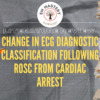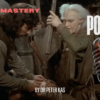If we don’t recognised the mimic, we can actually do harm to the patient by giving treatment that isn’t needed.
CASE 1
A holter monitor is done on a young patient who has complained of palpitations. His tracing is shown.
A diagnosis of VT is made. It’s easy to be tricked. See the second ecg below.
A similar interference pattern can occur secondary to tremor, or rigors, or someone just tapping on the lead.
Below is another case.
CASE 2
A 35 yo male with known Cardiomyopathy presents to the ED with chest pain.
The diagnosis of atrial flutter is made by the registrar, after seeing the rhythm on the monitor.
He is planning for definitive treatment; in this case cardioversion. That’s another discussion. (I wouldn’t necessarily cardiovert atrial flutter on presentation.)
An ECG is done.
Is this atrial flutter?
What else could it be if it isn’t flutter?
See the ECG below:
This is nothing more than artefact. If you look closely at the ECG you can see that the patient’s underlying rhythm. The tall QRS complexes (well seen in V4-6), are the patient’s underlying rhythm. There is left ventricular hypertrophy due to the patient’s cardiomyopathy. The waveforms in-between these, are simply artefact, just noise. In this case they are created due to the patients underlying tremor.
The 12 lead ECG was seen and the diagnosis of flutter was still entertained by the registrar.
If we look at this ECG, we can see where I’ve circled the complexes in lead III.
You can’t have atrial flutter in every lead, but lead III refuses to go into flutter. It’s artefact created by patient tremor and movement. It was easily reproduced by my tapping on the leads.
Now even though this wasn’t flutter we still needed to sort out the chest pain with serial Troponins.













